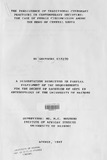| dc.description.abstract | Too much has been said about the practice of female circumcision.
There are long debates on this rite of passage today. Campaigns have been mounted against this practice without substantial achievement in some communities. This study was an attempt to try and establish the magnitude of the persistence of this practice and explore avenues of possible solutions.
The study considered the practice of female circumcision as so crucial, and as a result adopted rapid assessment test methods to be able to cover at least one distinct in such a short time. Nyambene District was chosen as a case study. The specific objectives were to search for a lucid explanation for the motives behind the recurrence of the practice of female circumcision in contemporary societies and therefore, to ascertain the role played by the practice in t he societies that do practice it. The study was also aimed at investigating for documentation, the effects of the practice on individuals and society as a whole. Another objective of the study was to analyze and describe the dynamics of female circumcision as exemplified by the Meru. Finally, the study wanted to make an assessment of societal response in terms of values and attitudes held by individuals regarding the practice of female circumcision.
The study established that the Meru of Nyambene District still practice female circumcision to a very large scale. The
persistence of this rite has been found to be rooted in the
socio-cultural importance attached to it.The study has also revealed that the Meru of Nyambene District do not fully understand the side effects of this practice. Finally,the study has made a revelation that the Meru of Nyambene District are likely to respond negatively to a possible legislation outlawing the rite.
The study is presented in five chapters.The first chapter introduces the subject,gives the problem statement,outlines the objectives of the study,and finally gives the rationale behind the study. Chapter two dwells on the literature review, definition of the hypotheses, and finally presents a brief discussion of the theoretical orientation adopted in the study.
Chapter three describes the research methods utilized in the study for effective and quick collection of data.Chapter four contains data presentation,analysis,and Intepretation. Chapter five is the final chapter and is specifically providing conclusions and recommendations of the study. It also gives suggestions for further research on female circumcision. | en |

